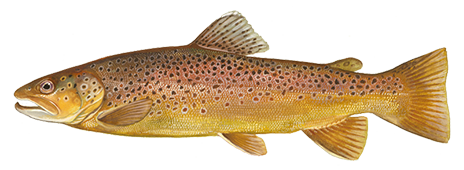
Brown Trout
The brown trout is one of the world’s most widely distributed and highly esteemed freshwater fish.

Region
Midwest, South, Northeast, West
Catch ease
Easy
Habitat
River, Ocean, Stream
How to identify a Brown Trout
It resembles its relative, the Atlantic salmon. Both have black spots on the back, upper sides, and on the gill cover, and sometimes have red spots. In fresh water especially near spawning time, both species are bronze to dark brown in general coloration, with black and (usually) red spots on the body and head. In salt water both species tend to become silvery with fewer black spots and no red spots. Though both often occur in the same areas, they can usually be distinguished without laboratory analysis. In fresh water, brown trouts as a rule, are more heavily spotted than Atlantic salmon and usually a good number of these spots are surrounded by lighter halos. The spots on the shape of Xs or Ys, which is not usually the case in the brown trout. The brown trout also has dark spots on the dorsal and adipose fins and vague spots on the tail, though nothing like the prominent radiating spots on the tail of the rainbow trout. The Atlantic salmon has no clear spots on any of these fins. Also, the brown trout’s tail is squarish or very slightly concave or convex, while the Atlantic salmons tail is slightly forked or indented. In juveniles the difference is much more obvious. The tail is slightly forked in the brown trout and deeply forked in the Atlantic salmon. Otherwise, these parr (young Salmonids) look very much alike with small exceptions. A positive distinction between these two species, usually observed in the laboratory, is that the brown trout has well-developed vomerine teeth in a double zigzag row, while the Atlantic salmon has only a single row of poorly developed vomerine teeth.
Where to catch Brown Trout
Native to Europe and parts of Asia, from Afghanistan and the Aral Sea across Europe to the British Isles and Iceland, and back across Scandinavia to Poluostrov Kanin (Cape Kanin), in Russia, on the Barents Sea. It has been introduced in other areas, notably, Newfoundland, Canada, U.S.A., South America, New Zealand, and Africa. Today it is found throughout the U.S.A. in the Great Lakes area, south in the Appalachian to the northern edge of Georgia, south in some high gradient streams and rivers of the Mississippi River drainage system, throughout much of Nebraska, and in every state west of Texas and Nebraska to the Pacific coast. The following list includes additional details on where to catch this fish:
| Outsides of Bends |
| Riparian Zones |
| Rock and Boulder Pockets |
| Drop-Offs |
| Merging Currents |
| Standing Waves |
| Current Edges |
| Overhanging Trees and Bushes |
| Rivers and Streams |
| Dams and Falls |
| Eddies |
| Small Pointed Waves |
| Undercuts |
How to catch Brown Trout
It is a prime target of fly fishermen and one of the most difficult of trouts to catch by any angling method. It will sometimes be spooked by the bait or fly and at other times it will simply ignore it. The following are fishing methods used to catch this fish:
Brown Trout lures, tackle & bait
The following are lures, tackle or bait that can be used to catch this fish:
